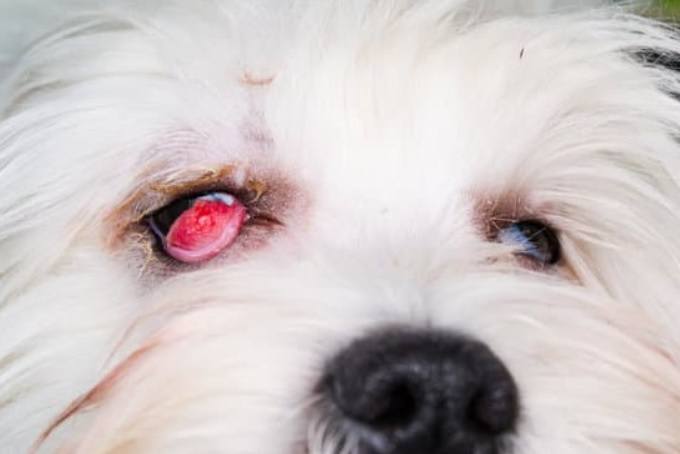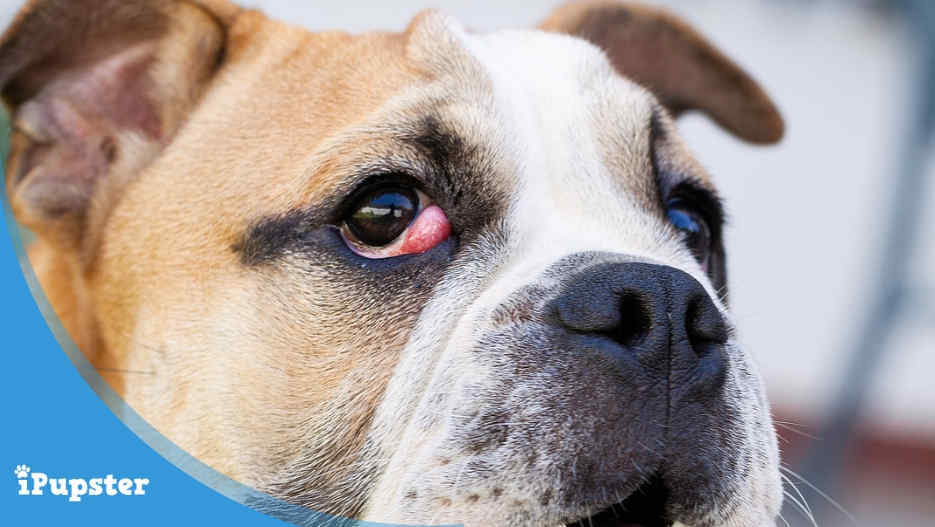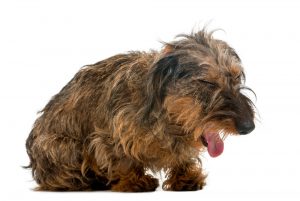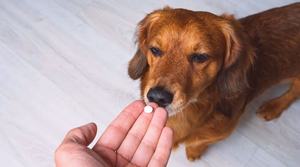
Reviewed & Fact-Checked by
Dr. Paula Simons
Veterinarian (DVM)
Learn more about our Veterinary Review Board »
Those puppy dog eyes are so cute, they melt your heart every time you see them. That's why when something appears to be wrong with them, it's scary and distressing.
Unfortunately, there are some eye diseases that dogs are susceptible to such as glaucoma, conjunctivitis or "dry eye". However, one of the most common conditions is known as cherry eye.
What is Cherry Eye?
Cherry eye is the common name used to describe a condition that is medically known as nictitating gland prolapse. The nictitating membrane in a dog's eye is what you probably refer to as his third eyelid.
Many animals have them, including all dogs and cats. When they are healthy and functioning properly they do a lot to protect an animal's eyes from all kinds of damage.
Cherry Eye: Prolapse of the gland of the third eyelid, or nictitans gland
Contained within the nictitating membrane is a tear gland. It produces tears to keep the eye lubricated. Cherry eye is an inflammation of this membrane that makes it noticeable swollen and visible, and often looks like a red mass, thus the name cherry eye.
What Causes Cherry Eye?

Example of Cherry Eye in a Dog
Just what causes cherry eye is still something of a mystery to veterinary medicine.
However, it is known that the formation of unwanted fat deposits in the eye may cause it, as will a sudden 'rolling' of the cartilage itself. Abnormal cells in the eye may also play a role and it is widely assumed that there is a genetic component involved in some cases too.
The majority of cases of cherry eye occur in dogs aged two and under, so this is not an 'old pup's' condition, as some mistakenly think.
Are Certain Dog Breeds More Prone to Cherry Eye?
Cherry eye can affect any pup at any age, but there are some pups who do seem to be more prone to developing it.
Often these are the smaller breeds whose eyes are naturally more prominent than many other breeds - Pugs for example - but also include all the following.
- American cocker spaniels
- Great Dane
- Lhasa Apsos
- Bloodhounds
- Shih Tsuz
- Beagles
- Pekingese
- Cane Corso
- Newfoundland
- Bulldogs
- Chinese Shar Pei
- Neopolitan mastiff
Just because your pup is a member of one of these canine families does not mean that they will develop cherry eye. Many do not, but it is helpful for pet parents to be aware of the fact that their pup may be at greater risk of doing so, while they are still relatively young.
How to Tell if Your Dog has Cherry Eye?
Visually, as it develops cherry eye is quite noticeable, as it appears, as we mentioned earlier, as a red 'bubble'. An affected pup may also paw at their eye or rub it against the ground, as their eye may be dry, itchy, and in some cases rather painful.
That pain may lead your pup to stop eating properly and it may also leave even the sweetest pup with a bad temper.
How is Cherry Eye Diagnosed?
As soon as you suspect your pup might be suffering from cherry eye he should be taken to his vet's office as soon as possible. There a visual examination is usually enough to confirm a diagnosis, but in some cases a vet may order diagnostics if they suspect a more serious condition may exist - cancer for example.
However, most of the time a complete ophthalmic examination is recommended which includes: a Schirmer tear test (assesses tear production), Fluorescein dye test (checks for corneal ulcers), and Tonometry (checks the pressure in the inside of the eye).
How Is Cherry Eye Treated?
There are two ways that cherry eye can be treated; surgically and non-surgically.
Non-surgical treatment for cherry eye calls for the administration of a steroid cream in an attempt to coax the eyelid back into place without further intervention and a course of antibiotics to prevent any secondary eye infections from interrupting the healing process. This is rarely successful and the pup will have to be watched carefully in the future to make sure that the condition does not reoccur.
There are two primary surgical approaches to correcting cherry eye. First approach and definitely the favored, deals with correcting the issue and securing the glad in the correct location. The second approach deals with surgical removal of the gland.
Cherry Eye Surgery
In the past, the gland would have been surgically removed. However, in the long-run, a large proportion of these animals developed a condition called keratoconjunctivitis sicca (or ‘Dry Eye’). This is a painful and potentially blinding condition which results from the surface of the eye being too dry from the lack of tears.
This condition is expensive to treat as it requires life-long medication, and causes the pet considerable discomfort.
Nowadays, doctors prefer to replace the gland so that it can still produce tears.
As we just discussed, not so long the complete removal of the affected nictitating membrane was the most common surgical option used to treat cherry eye but advances in surgical techniques are making surgical repositioning far more common these days. It will be up to your vet however to determine which is the best approach for your unique pup.
However, when surgical repositioning is done by a veterinarian skilled in the operation (such as a veterinary ophthalmologist), there is a high success rate of approximately 90%.
The price of cherry eye surgery depends on the severity of the condition and whether one or both eyes are involved; but you can expect to pay between $1,500 - $5,000.
Post-Cherry Eye Surgery
Right after surgery, the third eyelid will still appear inflamed and red, but the third eyelid is no longer inverted or ‘flipped-over’ like it was before surgery. Once the gland is in the normal position, the swelling will slowly reduce over a period of generally 2 weeks.
There may be a small amount of discharge from the eye which is grey or slightly brown, and owners should carefully remove by cleaning it twice daily.
In most cases, surgical intervention to correct cherry eye is very successful. Pups usually recover within a few weeks and their sight and eye function returns to normal. If the gland was repositioned no further treatment is usually called for after the postoperative recovery period.
Recovery from Cherry Eye Surgery
Your pet will be sent home with an antibiotic ointment and advised that he be kept calm and quiet for a minimum of 10 days post-surgery. They will need to wear a cone at all times to prevent them from rubbing the eye.
Walking on the lead should be kept at a minimum or entirely avoided if your pet pulls as this can put pressure on the neck causing the gland to protrude again. A dog harness like the Kyrgo Tru-Fit (Amazon link) as is a better alternative.
Prevention of Cherry Eye in Dogs
If the membrane was removed, your pup will need to be given eye drops to prevent infection and complications, usually for the rest of their lives. This small inconvenience aside, most pups whose nictitating membrane was removed will also regain normal use and function of their eye.
At the moment there are no medications or medical treatments considered effective to prevent cherry eye. However, paying greater attention to a pup's eye health in general can only be a good thing, not just to prevent cherry eye but to protect their eyes - and sight - in general.
To better care for their pup's eyes pet parents should keep their dog's hair out of their eyes as much as possible, and keep them clear and free of mucus. Sterile wipes are great choices to do this on a daily basis.
If you bathe your pup at home, it can be helpful if you apply a protective ophthalmic ointment (Chewy Link) before doing so, as even 'tearless' shampoos can irritate a pup's eyes.
Making sure that your pup gets enough eye healthy nutrients in their daily diet is a must too. These include beta-carotene, glutathione, Omega-3 fatty acids, lycopene and a combination of lutein and zeaxanthin, which some vets refer to as sunscreen for the eyes.
Foods that provide these nutrients in high concentrations include blueberries, broccoli, eggs, cold water fish like salmon and yes, Bugs Bunny was right, carrots are great for the eyes.




